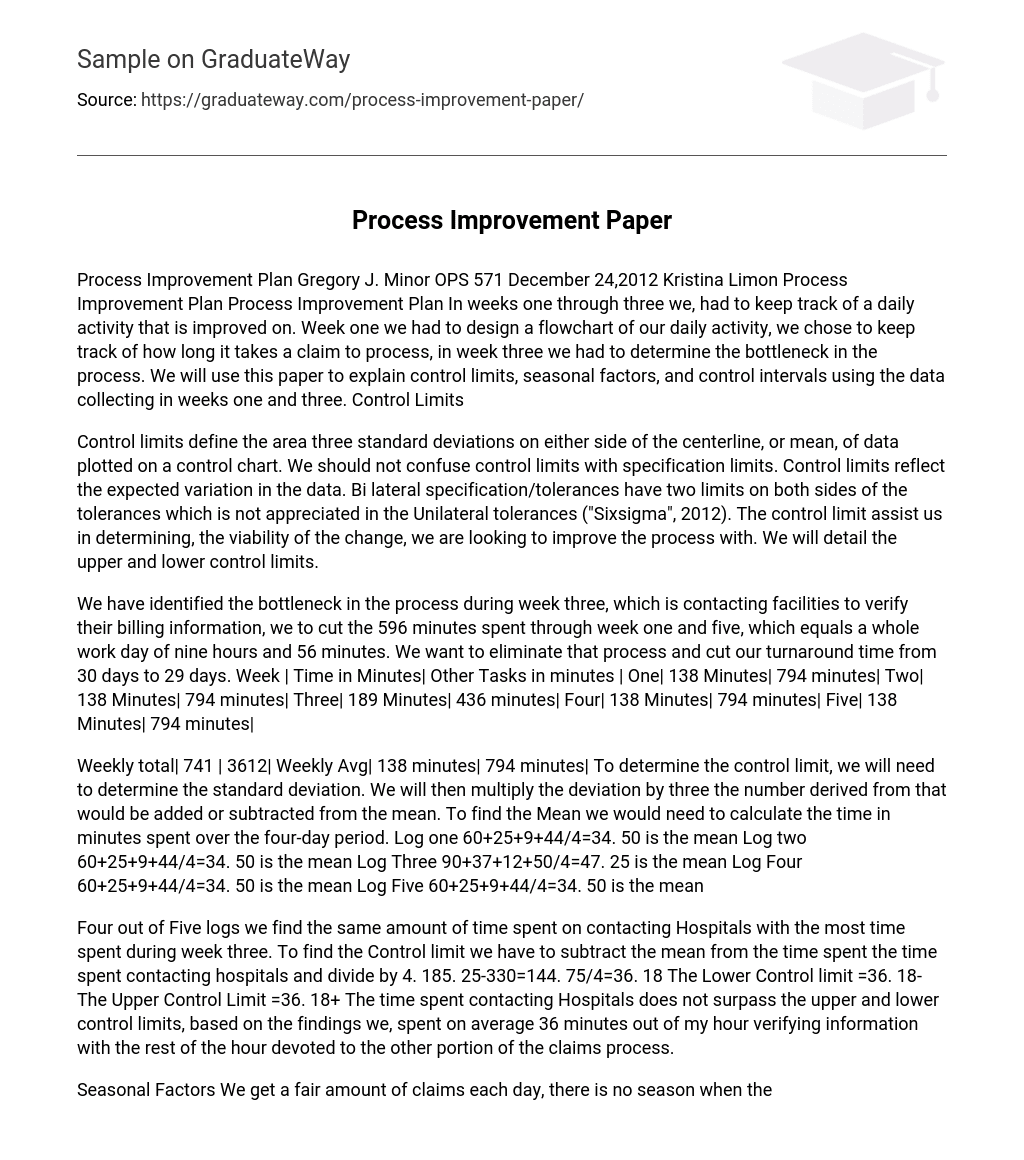In weeks one through three we, had to keep track of a daily activity that is improved on. Week one we had to design a flowchart of our daily activity, we chose to keep track of how long it takes a claim to process, in week three we had to determine the bottleneck in the process. We will use this paper to explain control limits, seasonal factors, and control intervals using the data collecting in weeks one and three.
Control Limits
Control limits define the area three standard deviations on either side of the centerline, or mean, of data plotted on a control chart. We should not confuse control limits with specification limits. Control limits reflect the expected variation in the data. Bi lateral specification/tolerances have two limits on both sides of the tolerances which is not appreciated in the Unilateral tolerances (“Sixsigma”, 2012). The control limit assist us in determining, the viability of the change, we are looking to improve the process with. We will detail the upper and lower control limits.
We have identified the bottleneck in the process during week three, which is contacting facilities to verify their billing information, we to cut the 596 minutes spent through week one and five, which equals a whole work day of nine hours and 56 minutes. We want to eliminate that process and cut our turnaround time from 30 days to 29 days.
Four out of Five logs we find the same amount of time spent on contacting Hospitals with the most time spent during week three. To find the Control limit we have to subtract the mean from the time spent the time spent contacting hospitals and divide by 4. 185. 25-330=144. 75/4=36. 18
The Lower Control limit =36. 18- The Upper Control Limit =36. 18+ The time spent contacting Hospitals does not surpass the upper and lower control limits, based on the findings we, spent on average 36 minutes out of my hour verifying information with the rest of the hour devoted to the other portion of the claims process.
Seasonal Factors
We get a fair amount of claims each day, there is no season when the claims are heavy or light, and everything is submitted . electronically so we are not waiting for the mail man after we have become a paperless department. We would only be able to factor whether or not the hospitals we did business with were outside our area, so bills are generated and submitted from local hospitals so our facility and theirs would experience the same problems brought on by a season change.
Eliminating the Bottleneck
The 36 minutes spent contacting hospitals is the bottleneck and to improve that for week five that portion of the process was cut and completed by the authorizers who make first contact with the providers, the elimination of this step has allowed us to focus on processing. In the place of contacting the provider, we could process 50 more claims a day, which turned into 150 more claims paid at the end of the fifth week. To prevent the bottleneck from happening in the future we will continue to have everything verified during the initial contact.
Confidence Intervals Confidence intervals allow us with certainty to state that our findings are correct, using the time in minutes and other task in minutes, we can apply a percentage of 90-95% to our findings A confidence interval is also itself an estimate. It is made using a model of how sampling, interviewing, measuring, and modeling contribute to uncertainty about the relation between the true value of the quantity we are estimating and our estimate of that value (census, 2012, p. 1. ).
Conclusion
In weeks one through five, we have tracked the amount of time spent processing claims, in week one, we created a diagram that outlined our daily activities. In week three we used the same chart and the daily log kept to determine the bottleneck in the process, which was found to be contacting hospitals to verify their billing information, which takes 138 to 189 minutes each day, which equates to 138 minutes = two hours and 18 minutes a day for three of the four days logged, and one-day spending 189 minutes = three hours and nine minutes. Week five we had to explain control limits and seasonal factors, and control intervals using the data.
References
- SixSigma. (2012). Retrieved from http://www. isixsigma. com/dictionary/control-limits/
- Census. (2012). Retrieved from http://www. census. gov/did/www/saipe/methods/statecounty/ci. html





